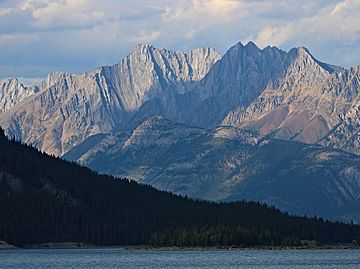Mount Evan-Thomas facts for kids
Quick facts for kids Mount Evan-Thomas |
|
|---|---|

Mount Evan-Thomas, centered in the sunlight.
Mount Packenham shaded to the right. |
|
| Highest point | |
| Elevation | 3,098 m (10,164 ft) |
| Prominence | 1,010 m (3,310 ft) |
| Parent peak | Mount Rae (3225 m) |
| Listing | Mountains of Alberta |
| Geography | |
| Location | Alberta, Canada |
| Parent range | Opal Range Canadian Rockies |
| Topo map | NTS 82J/14 |
| Type of rock | sedimentary rock |
| Climbing | |
| First ascent | 1954 by M.S. Hicks, W. Lemmon, G. Ross, I. Spreat, J.F. Tarrant |
| Easiest route | Scrambling YDS 4 with exposure |
Mount Evan-Thomas is a tall mountain peak in the Canadian Rockies in Alberta, Canada. It stands about 3,098 meters (10,164 feet) high. This makes it the highest point in the Opal Range.
You can find Mount Evan-Thomas in the Kananaskis River Valley. It is located northeast of Lower Kananaskis Lake. The mountain is also east of Highway 40, inside Peter Lougheed Provincial Park. The closest higher mountain is Mount Rae, which is about 18 kilometers (11 miles) to the south-southeast.
History of Mount Evan-Thomas
This mountain was named after Sir Hugh Evan-Thomas (1862–1928). He was a high-ranking officer, called a Rear Admiral, in the Royal Navy. He led a large group of warships, known as the 5th Battle Squadron. This was during a major sea battle called the Battle of Jutland in World War I.
The mountain's name was first approved in 1922. At that time, it was accidentally spelled "Mount Evans-Thomas." The spelling mistake was fixed in 1972. That's when the mountain's current name became official.
The first time people successfully climbed to the top of Mount Evan-Thomas was in 1954. The climbers were M.S. Hicks, W. Lemmon, G. Ross, I. Spreat, and J.F. Tarrant.
How Mount Evan-Thomas Was Formed
Mount Evan-Thomas is made of sedimentary rock. This type of rock forms from layers of sand, mud, and other materials that settle over time. These layers were laid down during very old periods of Earth's history, from the Precambrian to the Jurassic times.
These rocks were formed in shallow seas. Later, powerful forces pushed this sedimentary rock eastward. It was pushed up and over younger rock layers during an event called the Laramide orogeny. Mount Evan-Thomas was created during a specific part of this process called the Lewis Overthrust.
The rock layers in the Opal Range are steeply tilted. This means they are slanted at a sharp angle. Softer rock layers are often found between harder layers.
Weather and Climate at Mount Evan-Thomas
Mount Evan-Thomas is in a subarctic climate zone. This means it has very cold and snowy winters. The summers are usually mild. Temperatures can drop below −20 °C (–4 °F). With the wind chill, it can feel even colder, sometimes below −30 °C (–22 °F).
If you want to climb Mount Evan-Thomas, the best months are from June through September. The weather is usually more favorable during this time.
Water from rain and melting snow runs off the mountain. This runoff flows into smaller streams that feed into the Kananaskis River.



